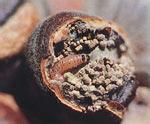Pollution-free cultivation techniques of Castanea mollissima

The main results were as follows: (1) the superior seed grafted seedlings were used in the planting seedlings, and the row spacing was 2 m × 3 m. The planting holes of 1 m long, 1 m wide and 1 m deep were dug and the seedlings were soaked in 500 times of glycerol water for 10-20 h before planting. There are two planting methods: 1) fill the waste wine bottle or tin can with water, insert one side root of the seedling (about 0.3 cm) into the bottle, bury the seedling and the bottle together into the planting hole, pour enough water, and repair the tree plate into a funnel with a diameter of 1 m, 10 ~ 15 cm below the ground, and then cover with plastic film to prevent water evaporation. 2) in spring, the seedlings were planted in hospital nutrition bags for centralized management to prevent the harm of spring drought and underground pests in early spring, and then transplanted to the garden with bags after the rainy season. (2) Fertilizer and water management of the park with water pouring conditions, 667 square meters of ammonium bicarbonate 50kg and borax 0.5kg before germination, 667 square meters of Sakefu three-element compound fertilizer 50kg in the rainy season, and 4000 kg; of farm manure in autumn, with emphasis on applying 100kg special fertilizer for Chinese chestnut or Sakefu 50kg plus ammonium bicarbonate 50kg plus borax 0.5kg in the rainy season. (3) shaping and pruning Castanea mollissima is a light-loving tree species, and the use of happy shape is beneficial to high yield, stable yield and high quality. Young trees and prosperous trees after grafting adopt the techniques of sprouting and branch drawing in spring to ensure high yield in the same year. Mature trees adopt the fine pruning technique of leaving 8 fruiting mother branches per square meter of crown. (4) male thinning can be divided into two types: artificial male thinning and chemical male thinning. The young trees were artificially thinned in late May, when the female inflorescences at the top of the branches had already appeared, 95% of the male inflorescences were removed artificially, and a small amount of male inflorescences on the top branches of the crown were retained, which could increase the yield by more than 40%. Chemical thinning was carried out in mid-May, when the mixed inflorescence protruded 1 × 2 cm, the tree was sprayed with 300-fold hydrophobic solution, and the shedding of 7~lO d male inflorescence reached 60% Mel 70%, which could increase the yield by more than 30%. (5) main pest control 5.1 spider mites scrape off the rough bark on the trunk and main branches in winter and burn them centrally, and spray 5-degree stone sulfur mixture before germination. Plant leaf mites under trees to avoid crops (Gramineae crops) to reduce the source of insects. 2000 times avermectin or 1000 times azadirachtin were sprayed in the first and middle of May. 5.2 the peach borer planted sunflowers around the closely planted young chestnut orchard and under the big trees, and the sunflower plates and culms were removed and burned from the chestnut orchard in autumn, which is an effective method to control peach borer. In the middle of July and the first ten days of August, the peach borer larvae were sprayed with 1000 times cypermethrin + 2000 times cypermethrin. In addition, a black light is installed every 2 hm2, which can trap and kill many kinds of pests, such as peach borer, leaf curl, inchworm, black bean worm and so on. 6 grafting technique 1) variety selection. Can choose Dabanhong, Beiyu No. 2, Yanshan short branch, Yanshan Zaofeng, 2399 and so on. 2) scion collection and storage. Before the first ten days of March, the disease-free and insect-free strong branches were cut from the superior mother tree, 20 branches and 1 bundle were packed in plastic bags and stored in a cellar with damp and low temperature. 3) grafting period. It is suitable from mid-April to the end of April. Grafting is prohibited after the first wet rain in May. 4) grafting method. Skin grafting or abdominal skin grafting can greatly improve the survival rate and preservation rate. (7) the natural picking method should be adopted in the early stage of timely harvest, and after 60% picking up, the chestnut canopy will be knocked down and the kernel will be collected after stacking.
- Prev

Symptoms of chestnut blight
Symptoms of chestnut blight: the pathogen produced discolored spots on the smooth bark, round or irregular; on the rough bark, the edge of the spot was not obvious, and then continued to expand, and the bark cracked longitudinally. In spring, many orange verrucous constellations can be seen on the damaged bark. After autumn, the constellation changes from orange to sauce red.
- Next

How to increase the yield of sugarcane
How to increase the yield of sugarcane
Related
- Moge, come on! The staff of the peasant association in the producing area of cantaloupe were frightened when the crowd gathered.
- Causes and Solutions of low Fruit setting rate of Apple
- Symptoms and control measures of passion fruit virus disease
- Fruit growing lesson: how do apple orchards keep high yields?
- Can you build orchards in the mountains? What are the pros and cons?
- How to manage the coloring period of Crisson grape?
- This paper introduces the processing technology of two kinds of fig products.
- How much is a month for retired teachers in rural areas by 2020?
- How can strawberry planting increase sugar content? We should pay attention to management in many aspects.
- What are the cultivation techniques on how to improve the yield of golden fruit?

